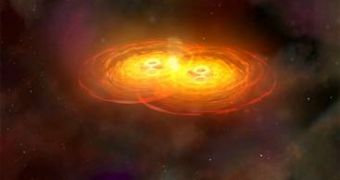Astronomers have just received infrared images that showed the exact location of a tremendous space collision between two supermassive black holes at the centers of two galaxies merging, 300 million light-years away.
New images were taken by Hawaii's Keck II telescope and show the two black holes at the center of the galaxy merger known as NGC 6240. Around each black hole there is a rotating disk of stars and both are dragging along cloudy stellar nurseries.
Previous observations of the collision have been made, in different light wavelengths. Hubble Space Telescope used visible light to show the outer parts of the colliding galaxies and long tidal Tails made of orphaned stars, gas and dust.
Chandra X-ray Observatory has revealed the presence of two supermassive black holes at the center of each galaxy and the Very Long Baseline Array spotted two radio sources in the galaxies' central regions.
This is the first time astronomers have been able to compose all these images to form a single coherent picture, with the help of Keck II. The last images that the telescope provided were of such high spatial resolution that scientists could identify features in NGC 6240 captured by the other telescopes in the optical, X-ray and radio wavelengths and calibrate the different previous images.
"You have all these different telescopes, and they look at the same piece of sky but see wildly different things," said study team member Willem de Vries of the University of California at Davis.
"Now we can really see it all - the hot dust in the infrared, the stars in the visible and infrared, and the X-rays and radio emissions from right around the black holes," said study leader Claire Max at the University of California at Santa Cruz.
Most astrophysicists believe that this kind of galactic merges is one the most important process to create new galaxies.

 14 DAY TRIAL //
14 DAY TRIAL //